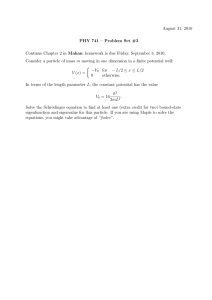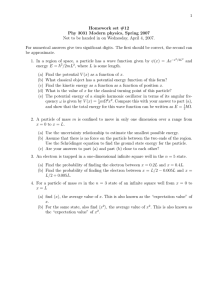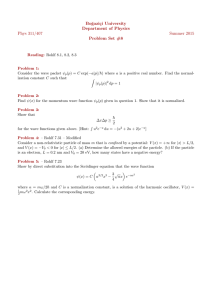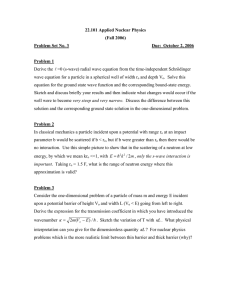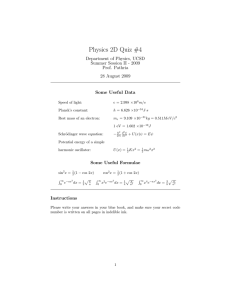Schrödinger Equation: Quantum Mechanics Textbook Chapter
advertisement
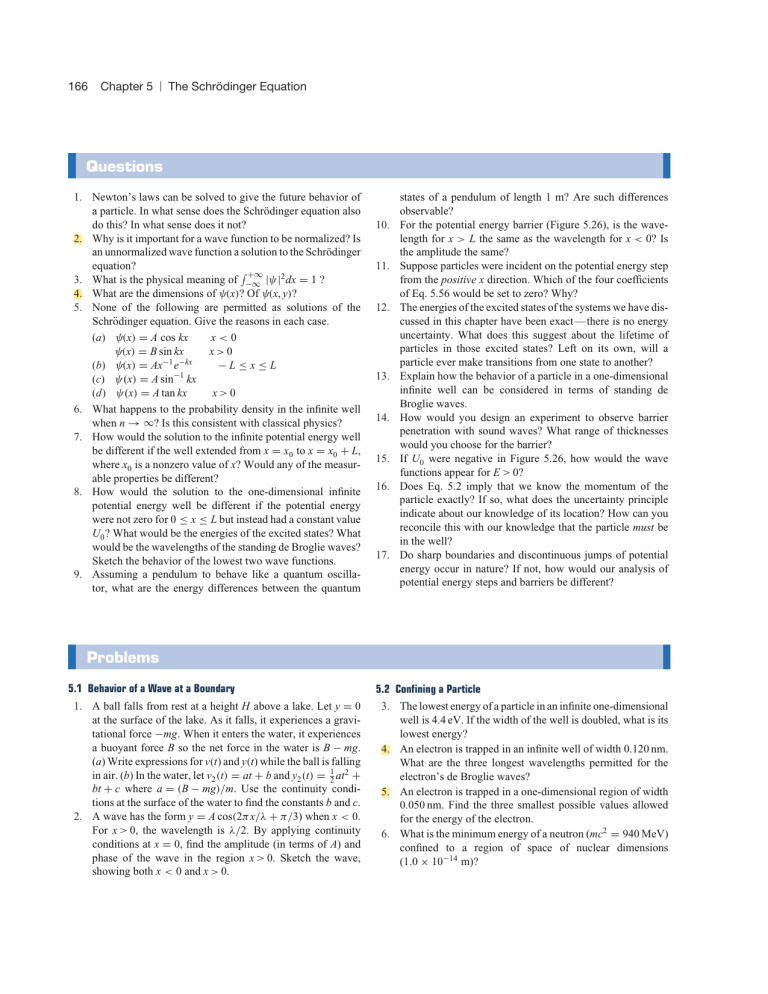
166 Chapter 5 | The Schrödinger Equation Questions 1. Newton’s laws can be solved to give the future behavior of a particle. In what sense does the Schrödinger equation also do this? In what sense does it not? 2. Why is it important for a wave function to be normalized? Is an unnormalized wave function a solution to the Schrödinger equation? +∞ 3. What is the physical meaning of −∞ |ψ|2 dx = 1 ? 4. What are the dimensions of ψ(x)? Of ψ(x, y)? 5. None of the following are permitted as solutions of the Schrödinger equation. Give the reasons in each case. (a) ψ(x) = A cos kx x<0 ψ(x) = B sin kx x>0 −L≤x≤L (b) ψ(x) = Ax−1 e−kx (c) ψ(x) = A sin−1 kx (d) ψ(x) = A tan kx x>0 6. What happens to the probability density in the infinite well when n → ∞? Is this consistent with classical physics? 7. How would the solution to the infinite potential energy well be different if the well extended from x = x0 to x = x0 + L, where x0 is a nonzero value of x? Would any of the measurable properties be different? 8. How would the solution to the one-dimensional infinite potential energy well be different if the potential energy were not zero for 0 ≤ x ≤ L but instead had a constant value U0 ? What would be the energies of the excited states? What would be the wavelengths of the standing de Broglie waves? Sketch the behavior of the lowest two wave functions. 9. Assuming a pendulum to behave like a quantum oscillator, what are the energy differences between the quantum 10. 11. 12. 13. 14. 15. 16. 17. states of a pendulum of length 1 m? Are such differences observable? For the potential energy barrier (Figure 5.26), is the wavelength for x > L the same as the wavelength for x < 0? Is the amplitude the same? Suppose particles were incident on the potential energy step from the positive x direction. Which of the four coefficients of Eq. 5.56 would be set to zero? Why? The energies of the excited states of the systems we have discussed in this chapter have been exact—there is no energy uncertainty. What does this suggest about the lifetime of particles in those excited states? Left on its own, will a particle ever make transitions from one state to another? Explain how the behavior of a particle in a one-dimensional infinite well can be considered in terms of standing de Broglie waves. How would you design an experiment to observe barrier penetration with sound waves? What range of thicknesses would you choose for the barrier? If U0 were negative in Figure 5.26, how would the wave functions appear for E > 0? Does Eq. 5.2 imply that we know the momentum of the particle exactly? If so, what does the uncertainty principle indicate about our knowledge of its location? How can you reconcile this with our knowledge that the particle must be in the well? Do sharp boundaries and discontinuous jumps of potential energy occur in nature? If not, how would our analysis of potential energy steps and barriers be different? Problems 5.1 Behavior of a Wave at a Boundary 5.2 Confining a Particle 1. A ball falls from rest at a height H above a lake. Let y = 0 at the surface of the lake. As it falls, it experiences a gravitational force −mg. When it enters the water, it experiences a buoyant force B so the net force in the water is B − mg. (a) Write expressions for v(t) and y(t) while the ball is falling in air. (b) In the water, let v2 (t) = at + b and y2 (t) = 12 at2 + bt + c where a = (B − mg)/m. Use the continuity conditions at the surface of the water to find the constants b and c. 2. A wave has the form y = A cos(2π x/λ + π/3) when x < 0. For x > 0, the wavelength is λ/2. By applying continuity conditions at x = 0, find the amplitude (in terms of A) and phase of the wave in the region x > 0. Sketch the wave, showing both x < 0 and x > 0. 3. The lowest energy of a particle in an infinite one-dimensional well is 4.4 eV. If the width of the well is doubled, what is its lowest energy? 4. An electron is trapped in an infinite well of width 0.120 nm. What are the three longest wavelengths permitted for the electron’s de Broglie waves? 5. An electron is trapped in a one-dimensional region of width 0.050 nm. Find the three smallest possible values allowed for the energy of the electron. 6. What is the minimum energy of a neutron (mc2 = 940 MeV) confined to a region of space of nuclear dimensions (1.0 × 10−14 m)? Problems 5.3 The Schrödinger Equation 7. In the region 0 ≤ x ≤ a, a particle is described by the wave function ψ1 (x) = −b(x2 − a2 ). In the region a ≤ x ≤ w, its wave function is ψ2 (x) = (x − d)2 − c. For x ≥ w, ψ3 (x) = 0. (a) By applying the continuity conditions at x = a, find c and d in terms of a and b. (b) Find w in terms of a and b. 8. A particle is described by the wave function ψ(x) = b(a2 − x2 ) for −a ≤ x ≤ +a and ψ(x) = 0 for x ≤ −a and x ≥ +a, where a and b are positive real constants. (a) Using the normalization condition, find b in terms of a. (b) What is the probability to find the particle at x = +a/2 in a small interval of width 0.010a? (c) What is the probability for the particle to be found between x = +a/2 and x = +a? 9. In a certain region of space, a particle is described by the wave function ψ(x) = Cxe−bx where C and b are real constants. By substituting into the Schrödinger equation, find the potential energy in this region and also find the energy of the particle. (Hint: Your solution must give an energy that is a constant everywhere in this region, independent of x.) 10. A particle is represented by the following wave function: ψ(x) = 0 = C(2x/L + 1) = C(−2x/L + 1) =0 x < −L/2 − L/2 < x < 0 0 < x < +L/2 x > +L/2 (a) Use the normalization condition to find C. (b) Evaluate the probability to find the particle in an interval of width 0.010L at x = L/4 (that is, between x = 0.245L and x = 0.255L. (No integral is necessary for this calculation.) (c) Evaluate the probability to find the particle between x = 0 and x = +L/4. (d) Find the average value of x and the rms value of x: xrms = (x2 )av . 5.4 Applications of the Schrödinger Equation 11. A particle in an infinite well is in the ground state with an energy of 1.26 eV. How much energy must be added to the particle to reach the second excited state (n = 3)? The third excited state (n = 4)? 12. An electron is trapped in an infinitely deep one-dimensional well of width 0.251 nm. Initially the electron occupies the n = 4 state. (a) Suppose the electron jumps to the ground state with the accompanying emission of a photon. What is the energy of the photon? (b) Find the energies of other photons that might be emitted if the electron takes other paths between the n = 4 state and the ground state. 13. Show that Eq. 5.31 gives the value A = 2/L. 14. A particle is trapped in an infinite one-dimensional well of width L. If the particle is in its ground state, evaluate the probability to find the particle (a) between x = 0 and 15. 16. 17. 18. 19. 167 x = L/3; (b) between x = L/3 and x = 2L/3; (c) between x = 2L/3 and x = L. A particle is confined between rigid walls separated by a distance L = 0.189 nm. The particle is in the second excited state (n = 3). Evaluate the probability to find the particle in an interval of width 1.00 pm located at: (a) x = 0.188 nm; (b) x = 0.031 nm; (c) x = 0.079 nm. (Hint: No integrations are required for this problem; use Eq. 5.7 directly.) What would be the corresponding results for a classical particle? What is the next level (above E = 50E0 ) of the twodimensional particle in a box in which the degeneracy is greater than 2? A particle is confined to a two-dimensional box of length L h2 π 2 /2mL2 )(n2x + and width 2L. The energy values are E = (− 2 ny /4). Find the two lowest degenerate levels. Show by direct substitution that Eq. 5.39 gives a solution to the two-dimensional Schrödinger equation, Eq. 5.37. Find the relationship between kx , ky , and E. A particle is confined to a three-dimensional region of space of dimensions L by L by L. The energy levels h2 π 2 /2mL2 )(n2x + n2y + n2z ), where nx , ny , and nz are are (− integers ≥ 1. Sketch an energy level diagram, showing the energies, quantum numbers, and degeneracies for the lowest 10 energy levels. 5.5 The Simple Harmonic Oscillator 20. Using the normalization condition, show that the constant A hπ )1/4 for the one-dimensional simple has the value (mω0 /− harmonic oscillator in its ground state. 21. (a) At the classical turning points ±x0 of the simple harmonic oscillator, K = 0 and so E = U. From this relationship, show hω0 /k)1/2 for an oscillator in its ground state. that x0 = (− (b) Find the turning points in the first and second excited states. 22. Use the ground-state wave function of the simple harmonic oscillator to find xav , (x2 )av , and *x. Use the normalization hπ )1/4 . constant A = (mω0 /− 23. (a) Using a symmetry argument rather than a calculation, determine the value of pav for a simple harmonic oscillator. (b) Conservation of energy for the harmonic oscillator can be used to relate p2 to x2 . Use this relation, along with the value of (x2 )av from Problem 22, to find (p2 )av for the oscillator in its ground state. (c) Using the results of parts a hω0 m/2. and b, show that *p = − 24. The ground state energy of an oscillating electron is 1.24 eV. How much energy must be added to the electron to move it to the second excited state? The fourth excited state? 25. Compare the probabilities for an oscillating particle in its ground state to be found in a small interval of width dx at the center of the well and at the classical turning points. 168 Chapter 5 | The Schrödinger Equation 5.6 Steps and Barriers 26. Find the value of K at which Eq. 5.60 has its maximum value, and show that Eq. 5.61 is the maximum value of *x. 27. For a particle with energy E < U0 incident on the potential energy step, use ψ0 and ψ1 from Eqs. 5.57, and evaluate the constants B and D in terms of A by applying the boundary conditions at x = 0. 28. Using the wave functions of Eq. 5.55 for the potential energy step, apply the boundary conditions of ψ and dψ/dx to find B′ and C ′ in terms of A′ , for the potential step when particles are incident from the negative x direction. Evaluate the ratios |B′ |2 /|A′ |2 and |C ′ |2 /|A′ |2 and interpret. 29. (a) Write down the wave functions for the three regions of the potential energy barrier (Figure 5.26) for E < U0 . You will need six coefficients in all. Use complex exponential notation. (b) Use the boundary conditions at x = 0 and at x = L to find four relationships among the six coefficients. (Do not try to solve these relationships.) (c) Suppose particles are incident on the barrier from the left. Which coefficient should be set to zero? Why? 30. Repeat Problem 29 for the potential energy barrier when E > U0 , and sketch a representative probability density that shows several cycles of the wave function. In your sketch, make sure the amplitude and wavelength in each region accurately describe the situation. E E E FIGURE 5.34 Problem 32. General Problems 31. An electron is trapped in a one-dimensional well of width 0.132 nm. The electron is in the n = 10 state. (a) What is the energy of the electron? (b) What is the uncertainty in its momentum? (Hint: Use Eq. 4.10.) (c) What is the uncertainty in its position? How do these results change as n → ∞? Is this consistent with classical behavior? 32. Sketch the form of a possible solution to the Schrödinger equation for each of the potential energies shown in Figure 5.34. The potential energies go to infinity at the boundaries. In each case show several cycles of the wave function. In your sketches, pay attention to the continuity conditions (where applicable) and to changes in the wavelength and amplitude. 33. Show that the average value of x2 in the one-dimensional infinite potential energy well is L2 (1/3 − 1/2n2 π 2 ). 34. Use the result of Problem 33 to show that, for the infinite one-dimensional well, defining *x = (x2 )av − (xav )2 gives *x = L 1/12 − 1/2π 2 n2 . 35. (a) In the infinite one-dimensional well, what is pav ? (Use a symmetry argument.) (b) What is (p2 )av ? [Hint: What is (p2 /2m)av ?] (c) Defining *p = (p2 )av − (pav )2 , show that *p = hn/2L. 36. The first excited state of the harmonic oscillator has a wave 2 function of the form ψ(x) = Axe−ax . Follow the method outlined in Section 5.5 to find a and the energy E. Find the constant A from the normalization condition. 37. Using the normalization constant A from Problem 20 and the value of a from Eq. 5.49, evaluate the probability to find an oscillator in the ground state beyond the classical turning points ±x0 . This problem cannot be solved in closed, analytic form. Develop an approximate, numerical method using a graph, calculator, or computer. Assume an electron bound to an atomic-sized region (x0 = 0.1 nm) with an effective force constant of 1.0 eV/nm2 . 38. A two-dimensional harmonic oscillator has energy E = − hω0 (nx + ny + 1), where nx and ny are integers beginning with zero. (a) Justify this result based on the energy of the one-dimensional oscillator. (b) Sketch an energy-level diagram similar to Figure 5.21, showing the lowest 4 energy levels. For each level, show the value of E (in units of − hω0 ), the quantum numbers nx and ny , and the degeneracy. (c) Show that the degeneracy of each level is equal to nx + ny + 1.
